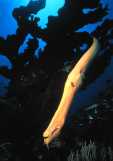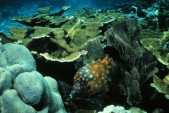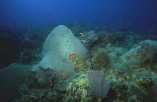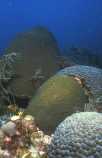
Grassroots support is vital to the success of marine sanctuaries. Marine sanctuaries protect our nation's most important marine ecosystems. Without grassroots support and continued public involvement, they would not exist. Since 1972, citizens have fought for 14 national marine sanctuaries in areas such as Massachusetts, Florida, California, and Washington. Once designated, sanctuaries belong to all of us, and come with a responsibility to preserve these special places for our children, and their children.
Marine sanctuaries strive to protect entire ecosystems by balancing resource protection with commercial, recreational, cultural, scientific, and educational uses. Marine sanctuaries are where we earn our living , experience the thrill of a whale watch or a first SCUBA dive, teach our children, connect with our cultural past, and research natural and human processes. Our challenge is to balance these and other important uses with long-term protection of the marine environment.
Protecting our coasts and oceans is as important for people living in Iowa, Kansas, or Colorado, as it is for those in Florida, California, or Hawaii. Our oceans and Great Lakes provide jobs, act as our favorite vacation spots, serve as natural classrooms for children across the country, hold the secrets to our past and the promises for the future. They are a national trust that we all have a responsibility to protect and enjoy.
click here for a summary of the issues that were cited as those most important during the Sanctuary's Public Scoping Process.

In 1990, Congress enacted the Florida Keys National Marine Sanctuary and Protection Act in recognition of the need to provide comprehensive protection and management of the diverse marine environments of the Florida Keys. These environments possess important and unique living and non-living resources, including seagrass meadows, mangrove islands, and extensive living coral reefs. These habitats support rich biological communities, possessing extensive conservation, recreational, commercial, ecological, historical, research, educational, and aesthetic values which give the area special national significance. Congress found these environments to be the marine equivalent of tropical rain forests in that they support a rich level of biological diversity, are fragile and easily susceptible to damage from human activities, and possess high value to human beings if properly conserved.
Past resource management efforts in the Florida Keys have only focused on small portions of the coral reef ecosystem in a checkerboard fashion. These efforts have not taken a holistic approach to protecting the marine environment of the Florida Keys and as a consequence, the coral reef resources have declined steadily over the past two decades. Piecemeal management of the marine resources of the Florida Keys, especially the coral reefs, seagrass communities, hardbottom habitats, and mangrove fringed shorelines, combined with a continued decline in the quality of the water that flows over these habitats, has resulted in a threat to the stability of the marine environment in the Keys. Consequently, since the economy of the Florida Keys is so closely linked to a healthy marine environment, the status quo approach to managing the marine resources of the Keys could result in an economic collapse in the near future.
The Sanctuary and Protection Act directed NOAA to develop a comprehensive management plan and implementing regulations for the Sanctuary in consultation with appropriate Federal, State and local governments and with the Sanctuary Advisory Council. Pursuant to this mandate, NOAA developed a comprehensive management plan and regulations to protect and manage the living and non-living resources of the Sanctuary1. Regulations were developed to protect Sanctuary resources and minimize conflicts among the various users of those resources. For example, establishing zones with special restrictions to protect habitat in those zones and prohibiting potentially harmful activities such as prop dredging and prop scarring throughout the Sanctuary are effective management tools. Regulations supplement, but do not duplicate, existing management authorities with jurisdiction in the Sanctuary.
 The Florida Keys National Marine Sanctuary will provide a comprehensive and coordinated regime to protect, manage and conserve the nationally significant resources of the Florida Keys so they may be enjoyed by both present and future generations. The concept of a National Marine Sanctuary as a "place" seems to be overlooked by some of the public. The Sanctuary is not a thing or an "extra layer of bureaucracy"; and it is not a collection of agencies, environmental groups, or user groups, it is a very special place, deserving of protection for the use and enjoyment of present and future generations. The waters and marine resources surrounding the Keys are unlike any other on earth and they need and deserve our immediate attention. We will lose our coral reefs if the declines we've witnessed over the past two decades continue. The Florida Keys National Marine Sanctuary will provide a comprehensive and coordinated regime to protect, manage and conserve the nationally significant resources of the Florida Keys so they may be enjoyed by both present and future generations. The concept of a National Marine Sanctuary as a "place" seems to be overlooked by some of the public. The Sanctuary is not a thing or an "extra layer of bureaucracy"; and it is not a collection of agencies, environmental groups, or user groups, it is a very special place, deserving of protection for the use and enjoyment of present and future generations. The waters and marine resources surrounding the Keys are unlike any other on earth and they need and deserve our immediate attention. We will lose our coral reefs if the declines we've witnessed over the past two decades continue.
There are many agencies involved in various management activities in the Keys. However, these activities have not been integrated in the past, and consequently there has not been a holistic approach to managing the fragile marine resources of the Keys. The potential benefits of integrated management of marine resources are numerous including better protection of the marine resources, savings to tax payers by agencies sharing resources, less duplication of efforts, opportunities for increased interagency coordination, and the list goes on.
The regulations do not usurp the authority or jurisdiction of other agencies within the boundary of the Sanctuary. The State will continue to have its authority in State waters and other Federal laws, such as the Magnuson Act, will continue to apply. However, those authorities cannot authorize violation of Sanctuary regulations, and the Sanctuary regulations are not authority to violate other State and Federal regulations.
Furthermore, NOAA has developed regulations that complement, rather than duplicate, existing authorities. In some cases, NOAA regulations supplement and fill gaps in existing authorities. To this end, NOAA has integrated its planning efforts with the Federal, State, and local agencies in the Florida Keys. This will improve management coordination between the agencies and will lessen the amount of agency overlap in key management areas such as education, research, enforcement, damage assessment, and emergency response. Through integrated planning and implementation, the Florida Keys National Marine Sanctuary will, at a minimum, streamline the use of public funds and programs to achieve resource protection. This will improve coordination between the various agencies responsible for management of the marine environment in the Sanctuary. Increased agency coordination will benefit Sanctuary resources and the public's use of those resources.
1For a copy of the Florida Keys National Marine Sanctuary Final Management Plan, contact the Marathon Office at (305) 743-2437.

Overview
The consideration of temporal and geographic zoning to ensure the protection of Sanctuary Resources is mandated under Section 7 (a) (2) of the Florida Keys National Marine Sanctuary and Protection Act. Marine zoning is a management tool that has been used around the world to protect sensitive marine resources from overuse and to separate conflicting visitor uses. Marine zoning is being implemented in the Florida Keys National Marine Sanctuary to assist in the protection of the biological diversity of the marine environment in the Keys. In addition, marine zoning will disperse uses of the resources in such a way as to reduce user conflicts and lessen the concentrated impact to marine organisms on heavily used reefs. As a management tool, marine zoning allows the Sanctuary to focus the majority of its management efforts on a small portion of the Sanctuary while addressing water quality and habitat degradation in the broader unzoned portions of the area.
In addition to the Existing Management Areas in the Keys (national wildlife refuges, state parks, etc.), Wildlife Management Areas, Ecological Reserves, Sanctuary Preservation Areas, and Special-use Areas are established to ensure protection of Sanctuary resources. Each of these zone types is designed to reduce damage to resources and threats to environmental quality, while allowing uses that are compatible with resource protection. The zones will protect habitats and species by limiting consumptive and/or conflicting user activities, and allowing resources to evolve in a natural state, with minimum human influence.
The Sanctuary's zoning program will be evaluated in the five-year update of the Management Plan, the effectiveness of the zones will be determined, and consideration will be given to modifying or eliminating zones at this time. A variety of research activities are currently underway as part of this five-year zone performance review.
Goals and Objectives
Zoning is critical to achieving the Sanctuary's primary goal of resource protection. Its purpose is to protect and preserve sensitive components of the ecosystem by regulating within the zoned areas, while facilitating activities compatible with resource protection. Zoning will ensure that areas of high ecological importance will evolve in a natural state, with minimal human influence. Zoning will also promote sustainable use of the Sanctuary resources, and will protect areas representing diverse Sanctuary habitats and areas important for maintaining natural resources (e.g., fishes, invertebrates, etc.) and ecosystem functions.
To achieve these goals, the following objectives must be accomplished:
- reduce stresses from human activities by establishing areas that restrict access to especially sensitive wildlife populations and habitats;
- protect biological diversity and the quality of resources by protecting large, contiguous diverse habitats that are intended to provide natural spawning, nursery, and permanent residence areas for the replenishment and genetic protection of marine life and to protect and preserve all habitats and species;
- minimize conflicting uses;
- protect Sanctuary resources and separate conflicting uses by establishing a number of non-consumptive zones in areas that are experiencing conflict between consumptive and non-consumptive uses and in areas that are experiencing significant population or habitat declines;
- eliminate injury to critical/sensitive habitats;
- disperse concentrated harvests of marine organisms;
- prevent heavy concentrations of uses that degrade Sanctuary resources;
- provide undisturbed monitoring sites for research activities by setting areas aside for scientific research, monitoring, and restoration; and
- provide control sites to help determine the effects of human activities on resources.
Zone Types
Wildlife Management Areas
These areas are established to minimize disturbance to especially sensitive wildlife populations and their habitats to ensure protection and preservation consistent with the Sanctuary designation and other applicable laws governing the protection and preservation of wildlife resources in the Sanctuary. Such areas would include bird nesting, resting, or feeding areas and turtle nesting beaches. Regulations governing access are designed to protect endangered or threatened species or their habitats, while providing opportunities for public use. Access restrictions include no-access buffer zones, no-motor zones, idle speed only/no wake zones, and closed zones. Twenty of the twenty-seven areas are under the management of the U.S. Fish and Wildlife Service and are contained in this plan as an integrated ecosystem management approach to resource protection. These areas are located within the Great White Heron, Key West, Key Deer, and Crocodile Lakes National Wildlife Refuges managed by the U.S. Fish and Wildlife Service.
Ecological Reserves
These areas are designed to encompass large, contiguous diverse habitats. They are intended to provide natural spawning, nursery, and permanent residence areas for the replenishment and genetic protection of marine life and to protect and preserve all habitats and species particularly those not protected by fishery management regulations. These reserves are intended to protect areas that represent the full range of diversity of resources and habitats found throughout the Sanctuary. The intent is to meet these objectives by limiting consumptive activities, while continuing to allow activities that are compatible with resource protection. This will provide the opportunity for these areas to evolve in a natural state, with a minimum of human influence. These zones will protect a limited number of areas that provide important habitat for sustaining natural resources such as fish and invertebrates. See note on the relationship between Ecological Reserves and Replenishment Reserves. provide natural spawning, nursery, and permanent residence areas for the replenishment and genetic protection of marine life and to protect and preserve all habitats and species particularly those not protected by fishery management regulations. These reserves are intended to protect areas that represent the full range of diversity of resources and habitats found throughout the Sanctuary. The intent is to meet these objectives by limiting consumptive activities, while continuing to allow activities that are compatible with resource protection. This will provide the opportunity for these areas to evolve in a natural state, with a minimum of human influence. These zones will protect a limited number of areas that provide important habitat for sustaining natural resources such as fish and invertebrates. See note on the relationship between Ecological Reserves and Replenishment Reserves.
Sanctuary Preservation Areas
 These areas will focus on the protection of shallow, heavily used reefs where conflicts occur between user groups, and where concentrated visitor activity leads to resource degradation. They are designed to enhance the reproductive capabilities of renewable resources, protect areas critical for sustaining and protecting important marine species, and reduce user conflicts in high-use areas. This will be accomplished through a prohibition of consumptive activities within these areas. They have been chosen based on the status of important habitat, the ability of a particular area to sustain and protect the habitat, the level of visitor use, and the degree of conflict between consumptive and nonconsumptive users. The actual size and location of these zones have been determined by examination of user patterns, aerial photography, and ground-truthing of specific habitats. These areas will focus on the protection of shallow, heavily used reefs where conflicts occur between user groups, and where concentrated visitor activity leads to resource degradation. They are designed to enhance the reproductive capabilities of renewable resources, protect areas critical for sustaining and protecting important marine species, and reduce user conflicts in high-use areas. This will be accomplished through a prohibition of consumptive activities within these areas. They have been chosen based on the status of important habitat, the ability of a particular area to sustain and protect the habitat, the level of visitor use, and the degree of conflict between consumptive and nonconsumptive users. The actual size and location of these zones have been determined by examination of user patterns, aerial photography, and ground-truthing of specific habitats.
Existing Management Areas
This zone simply identifies areas that are managed by other agencies where restrictions already exist. These zones delineate the existing jurisdictional authority of other agencies (i.e., State parks, aquatic preserves, sanctuaries, and other restricted areas). Management of these areas within the Sanctuary may require additional regulations or restrictions to adequately protect resources. Any additional management measures will be developed and implemented in coordination with the agency having jurisdictional authority. Their function is not to establish another layer of bureaucracy, but to recognize established management areas and, at a minimum, to complement the existing management programs, ensuring cooperation and coordination with other agencies.
Special-use Areas
These zones are used to set aside areas for scientific research and educational purposes, restoration, monitoring, or to establish areas that confine or restrict activities such as commercial personal watercraft operations and establish live-aboard mooring fields. These areas will minimize impacts on sensitive habitats and reduce user conflicts. Special management programs (e.g., monitoring, research, special-use permits and restoration) can be conducted without impediment in these areas. They can be used to set aside areas for specific uses such as long-term research and monitoring and/or minimizing the adverse environmental effects of high-impact activities. These zones will be limited in their length of duration.
Note: The term Ecological Reserves replaces the term Replenishment Reserves in the Final Management Plan/Environmental Impact Statement. NOAA has changed the name to reflect public concerns over the purpose of the areas, however, the objective and definition of this zone type remains the same. The main purpose of Ecological Reserves is to protect biodiversity by setting aside areas with minimal human disturbance. These zones will serve to protect and enhance the spawning, nursery or permanent resident areas of fish and other marine life. Hundreds of marine species are not protected by any form of management and the Ecological Reserves will provide protection and allow areas to return to their natural state. These areas will additionally protect the food and home of commercially and recreationally important species of marine life.
|


![]()

 The Florida Keys National Marine Sanctuary will provide a comprehensive and coordinated regime to protect, manage and conserve the nationally significant resources of the Florida Keys so they may be enjoyed by both present and future generations. The concept of a National Marine Sanctuary as a "place" seems to be overlooked by some of the public. The Sanctuary is not a thing or an "extra layer of bureaucracy"; and it is not a collection of agencies, environmental groups, or user groups, it is a very special place, deserving of protection for the use and enjoyment of present and future generations. The waters and marine resources surrounding the Keys are unlike any other on earth and they need and deserve our immediate attention. We will lose our coral reefs if the declines we've witnessed over the past two decades continue.
The Florida Keys National Marine Sanctuary will provide a comprehensive and coordinated regime to protect, manage and conserve the nationally significant resources of the Florida Keys so they may be enjoyed by both present and future generations. The concept of a National Marine Sanctuary as a "place" seems to be overlooked by some of the public. The Sanctuary is not a thing or an "extra layer of bureaucracy"; and it is not a collection of agencies, environmental groups, or user groups, it is a very special place, deserving of protection for the use and enjoyment of present and future generations. The waters and marine resources surrounding the Keys are unlike any other on earth and they need and deserve our immediate attention. We will lose our coral reefs if the declines we've witnessed over the past two decades continue.
 provide natural spawning, nursery, and permanent residence areas for the replenishment and genetic protection of marine life and to protect and preserve all habitats and species particularly those not protected by fishery management regulations. These reserves are intended to protect areas that represent the full range of diversity of resources and habitats found throughout the Sanctuary. The intent is to meet these objectives by limiting consumptive activities, while continuing to allow activities that are compatible with resource protection. This will provide the opportunity for these areas to evolve in a natural state, with a minimum of human influence. These zones will protect a limited number of areas that provide important habitat for sustaining natural resources such as fish and invertebrates. See
provide natural spawning, nursery, and permanent residence areas for the replenishment and genetic protection of marine life and to protect and preserve all habitats and species particularly those not protected by fishery management regulations. These reserves are intended to protect areas that represent the full range of diversity of resources and habitats found throughout the Sanctuary. The intent is to meet these objectives by limiting consumptive activities, while continuing to allow activities that are compatible with resource protection. This will provide the opportunity for these areas to evolve in a natural state, with a minimum of human influence. These zones will protect a limited number of areas that provide important habitat for sustaining natural resources such as fish and invertebrates. See  These areas will focus on the protection of shallow, heavily used reefs where conflicts occur between user groups, and where concentrated visitor activity leads to resource degradation. They are designed to enhance the reproductive capabilities of renewable resources, protect areas critical for sustaining and protecting important marine species, and reduce user conflicts in high-use areas. This will be accomplished through a prohibition of consumptive activities within these areas. They have been chosen based on the status of important habitat, the ability of a particular area to sustain and protect the habitat, the level of visitor use, and the degree of conflict between consumptive and nonconsumptive users. The actual size and location of these zones have been determined by examination of user patterns, aerial photography, and ground-truthing of specific habitats.
These areas will focus on the protection of shallow, heavily used reefs where conflicts occur between user groups, and where concentrated visitor activity leads to resource degradation. They are designed to enhance the reproductive capabilities of renewable resources, protect areas critical for sustaining and protecting important marine species, and reduce user conflicts in high-use areas. This will be accomplished through a prohibition of consumptive activities within these areas. They have been chosen based on the status of important habitat, the ability of a particular area to sustain and protect the habitat, the level of visitor use, and the degree of conflict between consumptive and nonconsumptive users. The actual size and location of these zones have been determined by examination of user patterns, aerial photography, and ground-truthing of specific habitats.